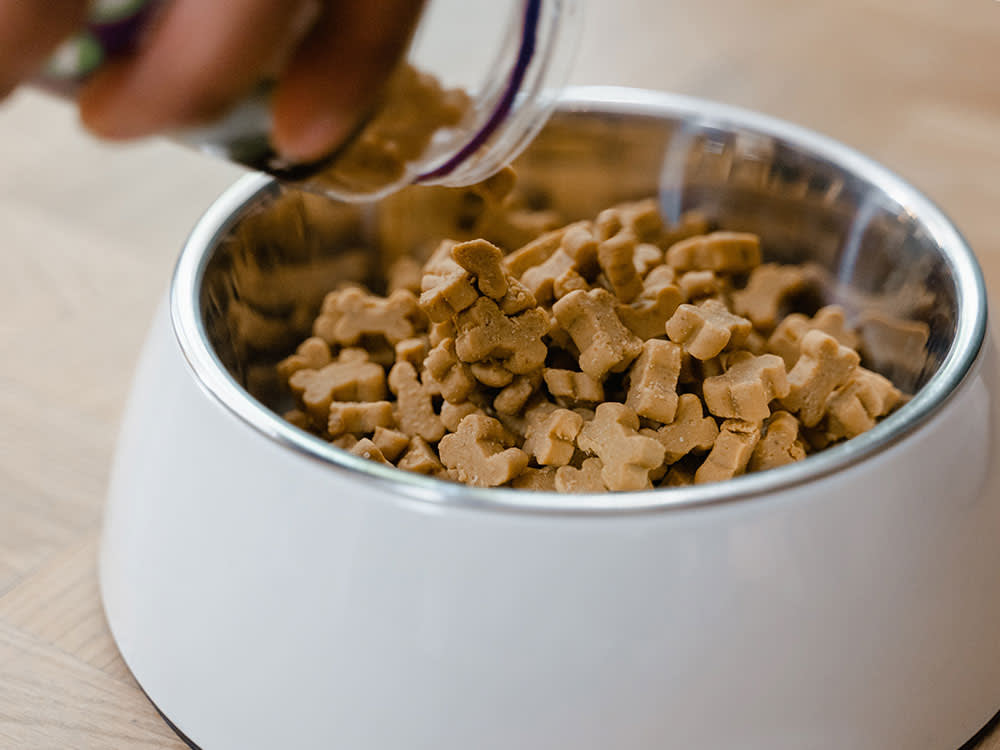BPA Linked to Health Concerns in Dogs
Plastics and endocrine-disrupting chemicals raise red flags.
Choosing alternatives to plastic is not only better for the environment, but research shows, it’s better for the health of both humans and dogs. Hundreds of studies have linked plastics to health problems, from reproductive disorders to cancer, including one shedding light on how people and animals are exposed to the plastic-hardening chemical Bisphenol A (BPA). While the FDAopens in new tab has reviewed the studies, they still consider BPA “safe at the current levels occurring in foods.”
Finding BPA in Canned Dog Foods
By measuring BPA’s escape from packaging, scientists are narrowing the focus on this chemical. One studyopens in new tab settled the debate over whether BPA — banned in baby bottles but used in many other items — seeps from metal can linings and taints human foods. (Hint: It does).
Snap a pic of your pup’s teeth, and GREENIES™ will help you spot potential signs of oral health issues.
Then, researchers at the University of Missouriopens in new tab found that eating canned dog food may increase a dog’s exposure to the endocrine-disrupting chemical. While the study was short-term, the results were “very revealing,” says investigator Dr. Cheryl Rosenfeld, an associate professor of biomedical sciences in the MU College of Veterinary Medicine. Fourteen healthy pets were switched from their usual diet of kibble to canned food. Would a two-week menu change raise the dogs’ BPA levels? Yep — It did, three-fold.
So, do you think if you skip canned food, you’ll spare your dog? Don’t be so sure. It turned out that the dogs in the MU study already had a small amount of BPA circulating in their blood, as shown by initial baseline samples. Since the dogs had some BPA in their blood before the study, bagged kibble might also contain BPA. Researchers also checked for any disturbances in gut bacteria and metabolic changes. The dogs showed gut microbiome and metabolic changes, with potential health consequences. Increased BPA may also reduce one bacterium known to metabolize BPA and related environmental chemicals, according to the study.
How much do you spend on your pet per year?
“The doses we found in the dogs after being on canned food though were comparable to what has been linked to health problems in humans and rodents,” a list that includes diabetes and obesity, among others. If the dogs continued to eat the canned food, would BPA keep building up in their bodies? In a previous rodent study, they did find that the longer mice were on a diet containing BPA, even though it was being metabolized, it would start accumulating in their system so that greater amounts would persist over time, she says.
The Problem with Plastics
The main concern about the gut microbiome changes is that they have been linked with various diseases, including neurological, metabolic, immunological, gastrointestinal, and possibly even cancer, she says. “Thus, by affecting the gut microbiome, BPA could induce such secondary effects.”
Another long-term study in the UK found a sharp decline in canine fertility associated with exposure to other endocrine-disrupting chemicals. Over the 26-year-long study, researchers found environmental chemicals lurking in the samples — chemicals that tamper with hormones. The chemicals included polychlorinated bisphenol (PCB), a compound banned in 1977, and diethylhexyl phthalate (DEHP). PCBs don’t readily break down while phthalates are common in a wide number of products, from cosmetics to detergents. Both chemicals are associated with fertility issues and birth defects.
The same environmental chemicals were found in a range of commercially available dog foods. DEHP and PCB153, “were detected in adult dog testes and commercial dog foods at concentrations reported to perturb reproductive function in other species.” The researchers considered food packaging a possible source, findingopens in new tab the chemicals in a range of dry and wet dog foods. Some plastic dog toys have also been found to leach the chemical. A studyopens in new tab at Texas Tech by environmental toxicologists Phil Smith and Kimberly Wooten found that BPA and phthalates leached from plastic toys and training tools.
Tips on Avoiding Plastic
Sustainable, natural, healthy options are more abundant than ever these days. Avoiding plastic isn’t easy but if you’re looking for ways to reduce your dependence on plastic, here are a few places to start:
Get new food and water bowls.
Stainless steel dog bowls are great because they’re resistant to chewing and easy to clean. By switching to stainless steel, you avoid the dangers of plastic. In addition to worries about leaching BPA, plastic bowls are easily scratched, which makes it easier for bacteria to grow and leads to microplastics.
Use stainless steel food storage containers.
Is it bad to keep dog food in a plastic container? While there are many plastic food storage options, even if they’re made of food-safe materials, it’s probably a good idea to choose a stainless steel version to minimize chemical leaching. Look for one large enough to hold enough dog food, like the one by Harry Barker.
Make the switch to compostable poop bags.
If you’re still using plastic poop bags, now is a great time to switch to recycled plastic or compostable bags. You might consider biodegradable poop bags but think again: these break down into microplastics. (If it seems like you can’t get away from plastic, you’re right.)
Use reusable cloth shopping bags.
It seems every store has its own version of reusable shopping bags. And using reusable bags has become very popular in recent years, but not all reusables are created equal. Some companies have reusable plastic bags that are just thicker versions of regular plastic bags — made of even more plastic.
Avoid single-use plastic bottles.
Filling stainless steel bottles with tap or filtered water will save you money while avoiding the potential risk of plastic. There are even stainless steel bottles specially made for pets that are perfect for travel.








